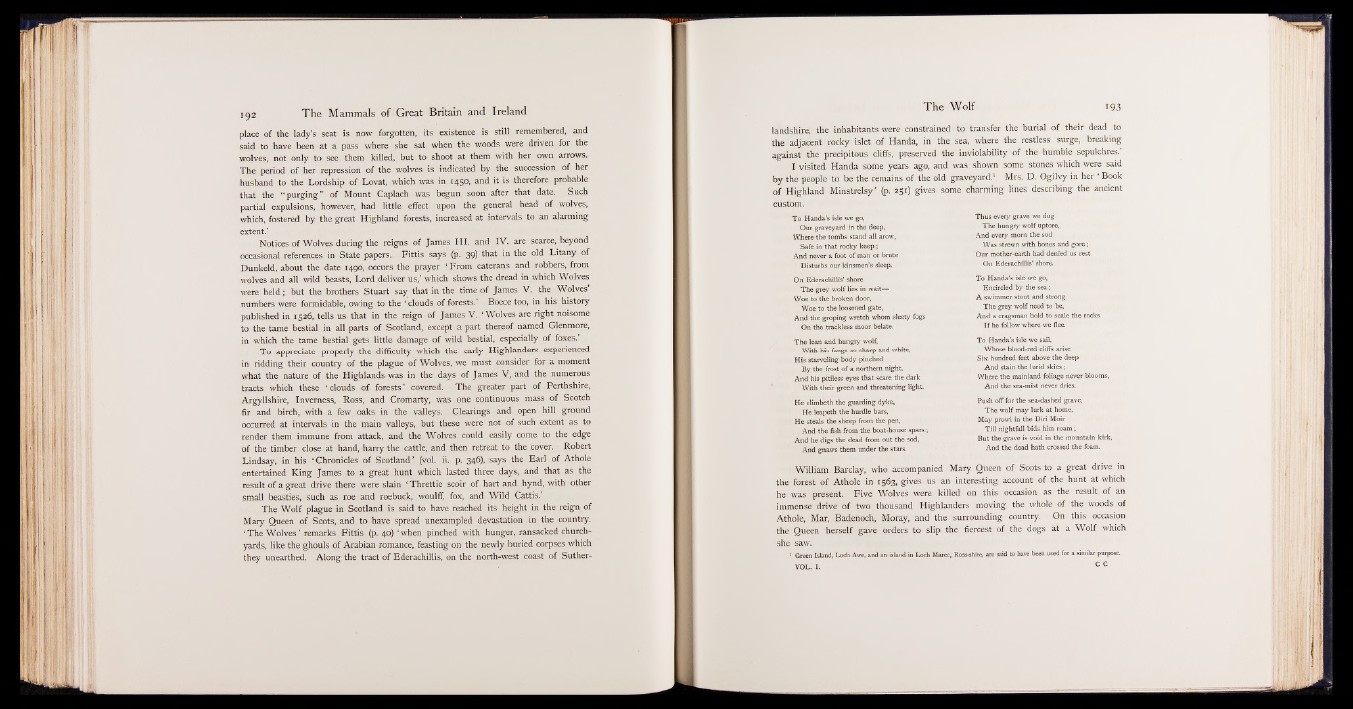
place of the lady’s seat is now forgotten, its existence is still remembered, and
said to have been at a pass where she sat when the woods were driven for the
wolves, not only to see them killed, but to shoot at them with her own arrows.
The period of her. repression of the wolves is indicated by the succession of her
husband to the Lordship of Lovat, which was in 145°» an<^ ^ *s therefore probable
that the “ purging” of Mount Caplach was begun soon after that date. Such
partial expulsions, however, had little effect upon the general head of wolves,
which, fostered by the great Highland forests, increased at intervals to an alarming
extent.’
Notices of Wolves during the reigns of James III. and IV. are scarce, beyond
occasional references in State papers. Fittis says (p. 39) that in the old Litany of
Dunkeld, about the date 1490, occurs the prayer ‘ From caterans and robbers, from
wolves and all wild beasts, Lord deliver us,’ which shows the dread in which Wolves
were held; but the brothers Stuart say that in the time of James V. the Wolves
numbers were formidable, owing to the ‘ clouds of forests.’ Boece too, in his history
published in 1526, tells us that in the reign of James V. ‘Wolves are right noisome
to the tame bestial in all parts of Scotland, except a part thereof named Glenmore,
in which the tame bestial gets little damage of wild bestial, especially of foxes.
To appreciate properly the difficulty which the early Highlanders experienced
in ridding their country of the plague of Wolves, we must consider for a moment
what the nature of the Highlands was in the days of James V, and the numerous
tracts which these ‘ clouds of forests ’ covered. The greater part of Perthshire,
Argyllshire, Inverness, Ross, and Cromarty, was one continuous mass of Scotch
fir and birch, with a few oaks in the valleys. Clearings and open hill ground
occurred at intervals in the main valleys, but these were not of such extent as to
render them immune from attack, and the Wolves could easily come to the edge
of the timber close at hand, harry the cattle, and then retreat to the cover. Robert
Lindsay, in his ‘ Chronicles of Scotland’ (vol. ii. p. 346), says the Earl of Athole
entertained King James to a great hunt which lasted three days, and that as the
result of a great drive there were slain ‘ Threttie scoir of hart and hynd, with other
small beasties, such as roe and roebuck, woulff, fox, and Wild Cattis.’
The Wolf plague in Scotland is said to have reached its height in the reign of
Mary Queen of Scots,, and to have spread unexampled devastation in the country.
‘ The Wolves ’ remarks Fittis (p. 40) ‘ when pinched with hunger, ransacked churchyards,
like the ghouls of Arabian romance, feasting on the newly buried corpses which
they unearthed. Along the tract of Ederachillis, on the north-west coast of Sutherlandshire,
the inhabitants were constrained to transfer the burial of their dead to
the adjacent rocky islet of Handa, in the sea, where the restless surge, breaking
against the precipitous cliffs, preserved the inviolability of the humble sepulchres.
I visited Handa some years ago, and was shown some stones which were said
by the people to be the remains of the old graveyard.1 Mrs. D. Ogilvy in her ‘ Book
of Highland Minstrelsy’ (p. 251) gives some charming lines describing the ancient
custom.
T o Handa’s isle we go,
Our graveyard in the deep,
Where the tombs stand all arow,
Safe in that rocky k e ep ;
And never a foot of man or brute
Disturbs our kinsmen’s sleep.
Thus every grave we dug
The hungry wolf uptore,
And every morn the sod
Was strewn with bones and gore ;
Our mother-earth had denied us rest
On Ederachillis' shore.
On Ederachillis’ shore
The grey wolf lies in wait—
Woe to the broken door,
Woe to the loosened gate,
And the groping wretch whom sleety fogs
On the trackless moor belate.
To Handa's isle we go,
Encircled by the s ea ;
A swimmer stout and strong
The grey wolf need to be,
And a cragsman bold to scale the rocks
I f he follow where we flee.
The lean and hungry wolf,
With his fangs so sharp and white,
His starveling body pinched
B y the frost o f a northern night,
And his pitiless eyes that scare the dark
With their green and threatening light.
He climbeth the guarding dyke,
He leapeth the hurdle bars,
He steals the sheep from the pen,
And the fish from the boat-house spars;
And he digs the dead from out the sod,
And gnaws them under the stars.
T o Handa’s isle we sail,
Whose blood-red cliffs arise
Six hundred feet above the deep
And stain the lurid skies ;
Where the mainland foliage never blooms,
And the sea-mist never dries.
Push off for the sea-dashed grave,
The wolf m ay lurk at home,
May prowl in the Diri Moir
Till nightfall bids him roam ;
But the grave is void in the mountain kirk,
And the dead hath crossed the foam.
William Barclay, who accompanied Mary Queen of Scots to a great drive in
the forest of Athole in 1563, gives us an interesting account of the hunt at which
he was present. Five Wolves were killed on this occasion as the result of an
immense drive of two thousand Highlanders moving the whole of the woods of
Athole, Mar, Badenoch, Moray, and the surrounding country. On this occasion
the Queen herself gave orders to slip the fiercest of the dogs at a Wolf which
she saw.
1 Green Island, Loch Awe, and an island in Loch Maree, Ross-shire, are said to have been used for a similar purpose.
VOL. I. C C